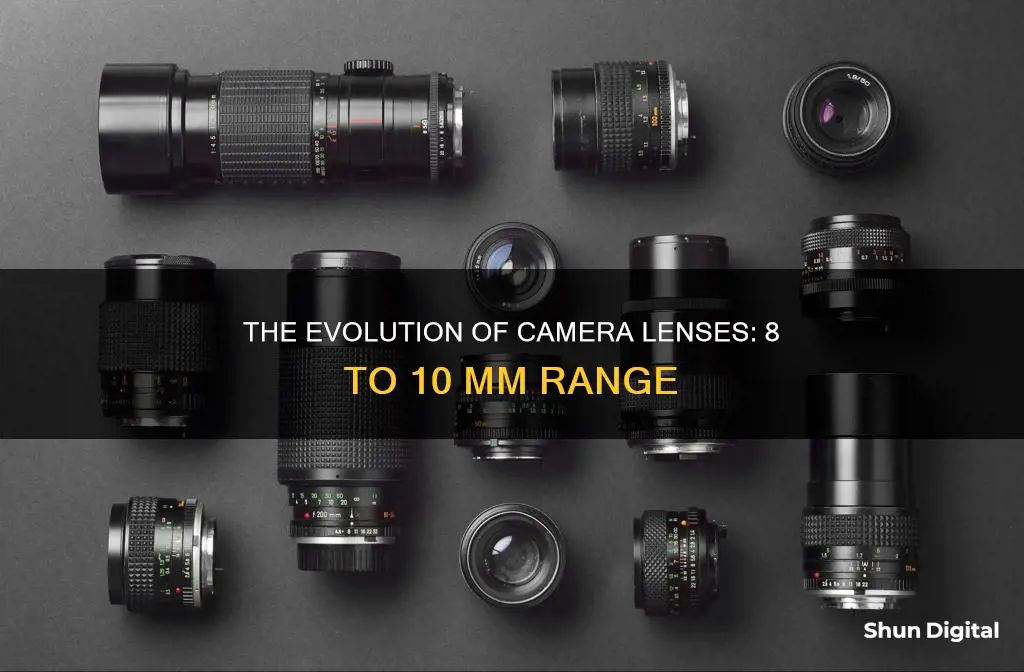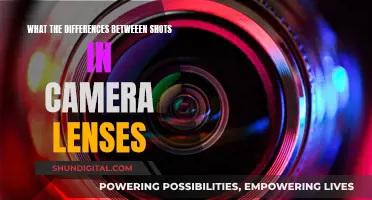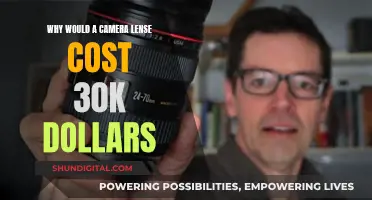
Camera lenses are one of the most important parts of a camera. They are an optical body that features a single lens or an assembly of lenses that are mounted onto the camera. Lenses are responsible for focusing light from what you see through the viewfinder into a tiny spot on the back of your camera. The lens's aperture governs the volume of light permitted through it, and the lens's role is to converge light onto the image sensor or film plane. The focal length of a lens, or the distance between the optical centre of the lens and the image plane, dictates the lens's field of view and magnification capabilities.
| Characteristics | Values |
|---|---|
| Purpose | Focuses light from what you see through the viewfinder into a tiny, (typically) 35mm spot on the back of your film, DSLR, or mirrorless camera |
| Function | Controls the amount of light that enters your camera |
| Parts | Front element, lens groups, aperture, rear element |
| Focal length | Determines the field of view |
| Aperture | Controls the amount of light passing through the lens |
| Focal plane | Parallel to the lens and sensor |
What You'll Learn
- Camera lenses focus light onto the image sensor or film plane
- Lenses can be interchangeable or permanently affixed to the camera body
- Aperture controls the volume of light permitted through the lens
- Focal length determines the field of view and magnification
- Depth of field describes how much of the photo is in focus

Camera lenses focus light onto the image sensor or film plane
A camera lens is the 'eye' of the camera, and the quality of the lens can make or break a photograph. The lens works by focusing light from the viewfinder onto the image sensor or film plane, usually measuring 35mm. Without a lens, the only image a camera can produce is white light.
Inside a camera lens are a number of lens elements, typically made from glass, which are arranged into various groups inside the lens casing. These lens elements are designed by optical engineers to allow light to enter the lens and hit the camera sensor, recording the image. Each lens element is ground down to have a specific curve, and these curves interact to direct the light.
The light entering the lens is bent and slowed, as it enters and exits the lens, and the camera lens's job is to direct that light onto the film or sensor. The lens collects the light rays and makes them converge onto the film or sensor at a single point, reproducing the image exactly as it appears to the human eye.
The lens's job is to focus light onto a single point, and the image sensor in a camera is a single flat plane, so only light sources from a single plane are ever in focus. If the light source is further away, the light will focus in front of the sensor, and if the light source is closer than the focus distance, it will focus behind the sensor.
The distance of the lens from the sensor or film can be adjusted to control where the captured light converges. When the light converges precisely at the plane of the film or sensor, the image is in focus.
The Importance of Pristine Camera Lenses for Perfect Pictures
You may want to see also

Lenses can be interchangeable or permanently affixed to the camera body
While it is typical for lenses to be interchangeable, some are designed to be permanently affixed to the camera body. These fixed lenses are often found on simpler cameras, such as disposable cameras or older film cameras. Fixed lenses offer the advantage of being more lightweight and compact, making the camera easier to carry around. However, they lack the flexibility of interchangeable lenses, limiting the photographer's creative options.
Interchangeable lenses, on the other hand, provide a wide range of creative possibilities. They allow photographers to experiment with different focal lengths, apertures, and other features to achieve their desired results. Interchangeable lenses are commonly found on DSLR (Digital Single-Lens Reflex) and mirrorless cameras, which are popular among enthusiasts and professionals.
When choosing between interchangeable and fixed lenses, consider your photography needs and preferences. Interchangeable lenses offer versatility but may be bulkier and more expensive. Fixed lenses provide convenience and portability but may limit your creative options. Ultimately, the decision depends on your specific requirements and budget constraints.
Sigma Lenses: Compatible with Full-Frame Cameras?
You may want to see also

Aperture controls the volume of light permitted through the lens
Aperture is the opening in a lens through which light passes to enter the camera. It is expressed in f-numbers like f/1.4, f/2, f/2.8, etc. to express the size of the lens opening, which can be controlled through the lens or the camera. The aperture of a lens is the opening that allows light to enter and reach the camera's sensor. It can be adjusted much like the irises of the human eye, which dilate or contract depending on the available light.
The aperture you choose also alters the exposure of your images by making them brighter or darker. Aperture has several effects on your photographs. One of the most obvious is the brightness or exposure of your images. As aperture changes in size, it alters the overall amount of light that reaches your camera sensor and, therefore, the brightness of your image.
Different lenses have their own range of aperture settings. Manufacturers calculate f-stop numbers for a particular lens by dividing its focal length by the aperture's diameter. The system is a bit counterintuitive, though, because smaller numbers indicate a larger aperture and larger numbers correspond to smaller openings.
What Camera Lenses Are Made Of: Metal or Myth?
You may want to see also

Focal length determines the field of view and magnification
The focal length of a lens determines the field of view and magnification of an image. Focal length is a measure of how strongly a lens converges or diverges light. It is typically represented in millimetres (mm) and is not a measurement of the actual length of the lens.
A longer focal length results in a narrower angle of view and higher magnification. Conversely, a shorter focal length provides a wider angle of view and lower magnification. This is because a shorter focal length bends light at sharper angles, bringing it to a focus more quickly.
For example, a lens with a focal length of 24mm will offer less magnification and a wider field of view than a lens with a focal length of 200mm.
Lenses with a longer focal length are known as telephoto lenses, while those with a shorter focal length are called wide-angle lenses. Telephoto lenses are often used for sports, wildlife, and portrait photography, as they allow photographers to capture close-ups of distant subjects. Wide-angle lenses, on the other hand, are popular for landscape photography and confined spaces due to their wider field of view.
Samy's Camera: Renting Lenses and Photography Equipment
You may want to see also

Depth of field describes how much of the photo is in focus
Depth of field is a crucial concept in photography, referring to the distance between the nearest and farthest objects in a photo that appears acceptably sharp. It is influenced by the camera type, aperture, and focusing distance, as well as viewing distance and print size.
Depth of field does not change abruptly from sharp to unsharp but occurs as a gradual transition. The term "circle of confusion" is used to define how much a point needs to be blurred to be considered unsharp. When this circle becomes perceptible to our eyes, the region is said to be outside the depth of field and is no longer acceptably sharp.
The aperture of a lens, or the opening that allows light to pass through to the sensor, plays a significant role in controlling depth of field. Larger apertures, corresponding to smaller f-stop numbers, result in a shallow depth of field, while smaller apertures or larger f-stop numbers produce images with a larger depth of field.
Additionally, the distance between the camera and the subject also affects depth of field. A shorter distance between the camera and the subject results in a shallower depth of field. This is why, even with a small aperture, it can be challenging to get the entire subject in focus when taking close-up shots.
It is worth noting that focal length does not directly influence depth of field. If the subject occupies the same fraction of the image for both a telephoto and a wide-angle lens, the depth of field remains almost constant. However, telephoto lenses often create a shallower depth of field because they are used to magnify the subject when the photographer cannot get closer.
By understanding and manipulating depth of field, photographers can selectively isolate subjects from their backgrounds, create sharp images from the foreground to infinity, or achieve the desired balance of focus and blur to convey their artistic vision effectively.
Lens and Camera Compatibility: Are Lenses Camera-Specific?
You may want to see also
Frequently asked questions
A camera lens focuses light from what you see through the viewfinder into a tiny spot on the back of your camera, creating a sharp image.
Camera lenses use glass to redirect light rays to a single point, creating a sharp image. The lens's focusing system moves the glass piece closer or farther from the sensor to adjust the focus.
There are five general categories of camera lenses: prime, zoom, wide-angle, telephoto, and macro. Prime lenses have a single focal length and are smaller and lighter than other lenses. Zoom lenses have a variable focal length that can be adjusted. Wide-angle lenses have a short focal length and a wide field of view. Telephoto lenses have a long focal length and are used for shooting subjects that are far away. Macro lenses are for extremely close focusing distances and can capture highly detailed images of small subjects.







